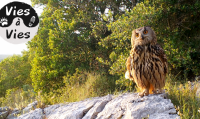The fauna of Pic Saint-Loup
By Nicolas Gaidet ecology researcher
What happens on the path, the river bank, the meadow behind our house, when we are not there?
A web-series to discover, throughout the seasons, this invisible and surprising fauna with which we share our territories. Filmed within a 10 km radius, these images reveal how humans and non-humans take turns to visit the same sites. To become aware of the living world that surrounds us... To renew contact with our neighbors... To question our way of living together...
Episode 1: A territory, between dog and otter
To become aware of the living world around us... To renew contact with our animal neighbors... To question our way of living together.
In order of appearance: kestrel, trailer, climber, weasel, eagle owl, motorist, weasel, genet, badger, deer, fox, wild boar, walker, dog, otter.

Episode 4: Mars, a shared trail
The hiking trails followed by humans are, at night, also widely used by different animal species. They take advantage of these open trails to move more easily through the forest in their search for food. But the layout of these trails also constitutes a reference point for orientation. Some large trees or fallen trunks, which are for us simple details of the landscape, are for these species real markers that they use to represent the "map" of their territory.
In order of appearance: squirrel, trailer, field mouse, weasel, genet, badger, fox, otter.
Episode 6: May, to beat my wings have begun
The rocky ridges are privileged sites for running and hiking. They are also home to many animal species. In late May, young eagle owls venture out of the nest where they have spent the last two months. These escapades allow them to develop their muscles before flight. Their parents will continue to feed them for several weeks on the cliff where they roam.
With their imposing size (up to 70 cm in height and 1m70 in wingspan) these superpredators feed on a wide variety of prey, from rodents to small carnivores (young foxes, genets...) and even birds of prey (buzzards, falcons, owls...). For some couples, hedgehogs are a prey of choice. Their quills are a very poor protection against this powerful raptor.
Great horned owls do not seem to fear the perforation of their digestive tract because pellets (remains of non-digested preys and regurgitated by the owls) furnished with quills are sometimes found.
In order of appearance: trailer, genet, red-legged partridge, eagle owl, motorist, roller, weasel.
Vies-à-Vies is an original work by Nicolas Gaidet, inspired by his research work within a Cirad collective that questions the way to represent the place of non-humans in our daily lives and in the management of our territories.
Vies-à-Vies is an opportunity to make visible the fauna that lives right around us, to become aware of its presence and its proximity to our own lives. It is also an opportunity to recreate a sensitive link with these animals by becoming familiar with their daily lives, close to our ordinary activities. It is an invitation to question the way of living together, human and non human, on a shared territory.
Director - Image - Sound - Post Production : Nicolas Gaidet
Drawing – Additional images : Tanguy Daufresne
Music : Samuel Vène
Graphic design : Solène Drouin
Episode 8: July, when we walk by the water
In July, rivers attract people who like to swim, canoe and picnic by the water. These shaded banks are also places where animal life is concentrated. It is therefore a privileged hunting ground for predators. The genets travel about 3 km each night in search of food. They only come out after dark, and return to their nest well before daybreak. Unlike foxes and weasels, which consume large quantities of fruit and insects, genets feed mostly on small mammals. Field mice, in particular, are their preferred prey in this territory.
In order of appearance: fox, swimmer, otter, genet, bat, field mouse, weasel, wild boar, badger, deer, canoeist.
Find all the reports of "Vies à Vies" on the Youtube channel Vies à Vies













